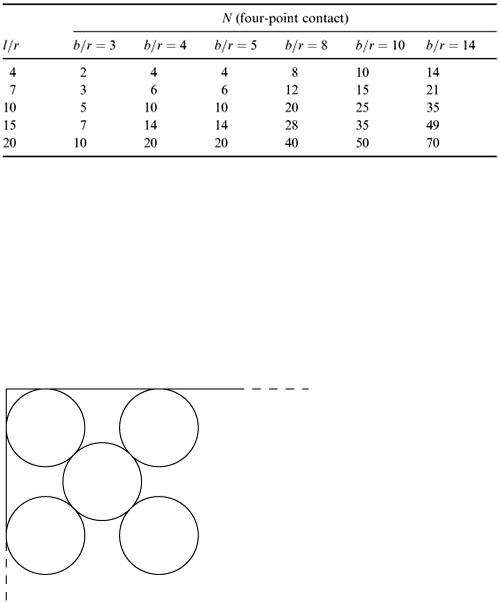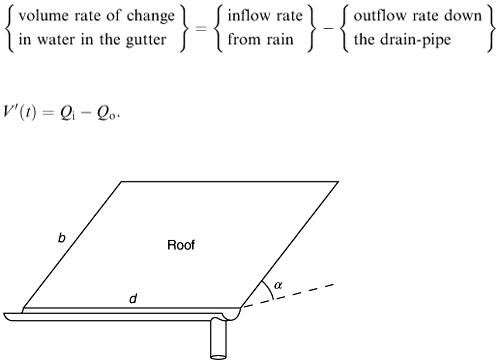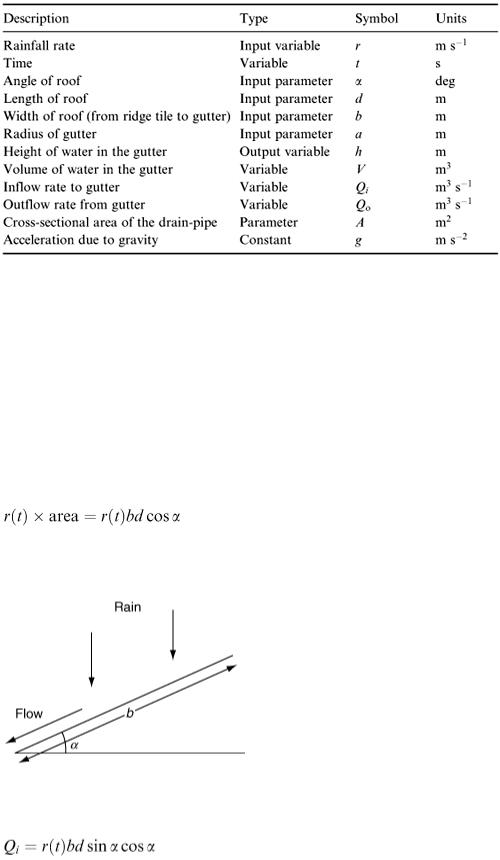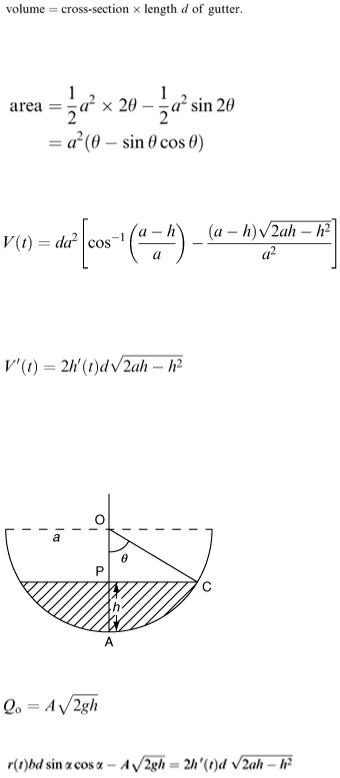
- •Preface
- •1.1 Introduction
- •1.2 Models and modelling
- •1.3 The learning process for mathematical modelling
- •Summary
- •Aims and objectives
- •2.1 Introduction
- •2.2 Examples
- •2.3 Further examples
- •Appendix 1
- •Appendix 2
- •Aims and objectives
- •3.1 Introduction
- •3.2 Definitions and terminology
- •3.3 Methodology and modelling flow chart
- •3.4 The methodology in practice
- •Background to the problem
- •Summary
- •Aims and objectives
- •4.1 Introduction
- •4.2 Listing factors
- •4.3 Making assumptions
- •4.4 Types of behaviour
- •4.5 Translating into mathematics
- •4.6 Choosing mathematical functions
- •Case 1
- •Case 2
- •Case 3
- •4.7 Relative sizes of terms
- •4.8 Units
- •4.9 Dimensions
- •4.10 Dimensional analysis
- •Summary
- •Aims and objectives
- •5.1 Introduction
- •5.2 First-order linear difference equations
- •5.3 Tending to a limit
- •5.4 More than one variable
- •5.5 Matrix models
- •5.6 Non-linear models and chaos
- •5.7 Using spreadsheets
- •Aims and objectives
- •6.1 Introduction
- •6.2 First order, one variable
- •6.3 Second order, one variable
- •6.4 Second order, two variables (uncoupled)
- •6.5 Simultaneous coupled differential equations
- •Summary
- •Aims and objectives
- •7.1 Introduction
- •7.2 Modelling random variables
- •7.3 Generating random numbers
- •7.4 Simulations
- •7.5 Using simulation models
- •7.6 Packages and simulation languages
- •Summary
- •Aims and objectives
- •8.1 Introduction
- •8.2 Data collection
- •8.3 Empirical models
- •8.4 Estimating parameters
- •8.5 Errors and accuracy
- •8.6 Testing models
- •Summary
- •Aims and objectives
- •9.1 Introduction
- •9.2 Driving speeds
- •Context
- •Problem statement
- •Formulate a mathematical model
- •Rewritten problem statement
- •Obtain the mathematical solution
- •9.3 Tax on cigarette smoking
- •Context
- •Problem statement
- •Formulate a mathematical model
- •Obtain the mathematical solution
- •9.4 Shopping trips
- •Context
- •Problem statement
- •Formulate a mathematical model
- •Obtain the mathematical solution
- •Interpret the mathematical solution
- •Using the model
- •9.5 Disk pressing
- •Context
- •Problem statement
- •Formulate a mathematical model
- •Obtain the mathematical solution
- •Interpret the mathematical solution
- •Further thoughts
- •9.6 Gutter
- •Context and problem statement
- •Formulate a mathematical model
- •Obtain the mathematical solution
- •9.7 Turf
- •Context
- •Problem statement
- •Formulate a mathematical model
- •Obtain the mathematical solution
- •Interpret the solution
- •9.8 Parachute jump
- •Context and problem statement
- •Formulate a mathematical model
- •Obtain the mathematical solution
- •9.9 On the buses
- •Context
- •Problem statement
- •Formulate a mathematical model
- •Obtain the mathematical solution
- •9.10 Further battles
- •Discrete deterministic model
- •Discrete stochastic model
- •Comparing the models
- •9.11 Snooker
- •Context
- •Problem statement
- •Formulate a mathematical model
- •Obtain the mathematical solution
- •Interpret the mathematical solution
- •9.12 Further models
- •Mileage
- •Heads or tails
- •Picture hanging
- •Motorway
- •Vehicle-merging delay at a junction
- •Family names
- •Estimating animal populations
- •Simulation of population growth
- •Needle crystals
- •Car parking
- •Overhead projector
- •Sheep farming
- •Aims and objectives
- •10.1 Introduction
- •10.2 Report writing
- •Preliminary
- •Main body
- •Appendices
- •Summary
- •General remarks
- •10.3 A specimen report
- •Contents
- •1 PRELIMINARY SECTIONS
- •1.1 Summary and conclusions
- •1.2 Glossary
- •2 MAIN SECTIONS
- •2.1 Problem statement
- •2.2 Assumptions
- •2.3 Individual testing
- •2.4 Single-stage procedure
- •2.5 Two-stage procedure
- •2.6 Results
- •2.7 Regular section procedures
- •2.8 Conclusions
- •3 APPENDICES
- •3.1 Possible extensions
- •3.2 Mathematical analysis
- •10.4 Presentation
- •Preparation
- •Giving the presentation
- •Bibliography
- •Solutions to Exercises
- •Chapter 2
- •Example 2.2 – Double wiper overlap problem
- •Chapter 4
- •Chapter 5
- •Chapter 6
- •Chapter 8
- •Index

Further thoughts
1.Can the figure of 105 be improved? If we use a mixed strategy of equal and unequal rows, we find that rows of 10, 9, 10, 9, 10, 9, 10, 9, 10, 10, 10 can be fitted, giving a total of 106 disks! A mixed strategy of this kind seems worth investigating.
2.Four-point contact does not have to be on a square arrangement. A staggered pattern can be adopted as shown in Figure 9.8. Investigate the efficiency of such patterns.
3.Can you extend the model to deal with cases of two different sizes of disks which are cut from the same sheet. Under what conditions can the smaller circles be fitted in between the larger ones?
Figure 9.8
9.6 Gutter
Context and problem statement
The building department of the local borough council require some specification on the size of gutters to fix to house roofs. In a particular new development, the roofs are all rectangular, 12 m long and 6 m from the ridge tile to the gutter. The angle of inclination of the roofs to the horizontal has not yet been decided, but will lie between 20° and 50°.
A guttering company is keen to get the contract from the council for the supply. The company say that their new durable plastic gutters will be sufficient and have always proved adequate no matter what the weather circumstances. The guttering cross-section is semicircular with radius 7.5 cm and the supplier claims that, for the roofs in question, one down drain-pipe of diameter 10 cm will be sufficient.

The council's chief housing expert is uncertain about the claims of the guttering supplier and so calls you in to set up a mathematical model so that a thorough analysis can be carried out before a bulk order for the plastic guttering is made. The housing chief is particularly interested in whether the size of the gutter will normally be sufficient to cope with a heavy fall of rain.
This investigation is concerned with the capacity of the gutter to hold rainwater. It is an input–output type of investigation that can occur in other situations such as the flow of water into and out of a water tank, river or reservoir. In this case the input comes from rainwater flowing in from the inclined roof and the output from the vertical drain-pipe(s). The critical question is whether the gutter can hold all the rainwater without overflow. This means that we are interested in the height of water in the gutter at a particular time. As the gutter cross-section is semicircular, then when the height of water is equal to the radius we shall get overflow.
Formulate a mathematical model
Following the systematic plan for mathematical modelling as we have done in previous cases, the first job is to list the relevant factors (Table 9.10).
The problem can be clarified with the aid of the diagram in Figure 9.9. We now apply a ‘rate of flow’ principle to the gutter system in the following form:
In terms of the notation given in Table 9.10, this is
(9.1)
Note that Q i and Q o are volume flow rates while the rainfall rate r is a linear rate measured in metres per second.
Figure 9.9
Table 9.10

Assumptions
We shall make a few minor assumptions concerning the flow.
1.All the rainwater falling on the roof will enter the gutter.
2.Rainwater falling directly into the gutter can be neglected.
3.There are no unforeseen blockages in the system due to leaves, etc.
4.Rain falls straight down onto the roof.
5.Rain does not splash away on hitting the roof.
The area of the roof is bd but, owing to the inclination, the area on which rain falls is bd cos α. As the rainfall rate is r ( t ), the volume rate of rainfall on the roof is
(9.2)
Also, the inclination of the roof will affect the flow rate into the gutter: the steeper the roof, the faster will be the flow of rain. Referring to Figure 9.10, we see that the component of the rain's velocity down the roof is required and this introduces a sin α term into our equation.
Figure 9.10
Hence an expression for the inflow of rain water into the gutter is
(9.3)
This is a simplification of what actually happens as rain is falling on top of water that is already

flowing down into the gutter.
Now the volume of water lying in the gutter at any moment can be found by considering the crosssection of the gutter as shown in Figure 9.11.
The volume is then found from
The cross-section is a segment of a circle. From the diagram, using θ to denote the angle AOC, the segment area is given by
but cos θ = ( a − h )/ a and so  . Hence,
. Hence,
(9.4)
What is in fact required is the rate of change of V ( t ).
Now V ′( t ) = (d V /d h )(d h /d t ) and an expression for d V /d h can be found from differentiating equation (9.4). After a little manipulation, we obtain
(9.5)
Now the outflow from the gutter is through the vertical drain-pipe. The velocity of the outflow is related to the height of water in the gutter, and the usual relation is obtained by applying Torricelli's law of energy conservation which states that potential energy lost over height h ( t ) is balanced by the
kinetic energy gained on exit down the pipe. Thus the exit velocity is  and, since the pipe crosssection is denoted by A, then the expression for the outflow is
and, since the pipe crosssection is denoted by A, then the expression for the outflow is
Figure 9.11
(9.6)
If we return to equation (9.1), substituting for the flow rates gives the differential equation
